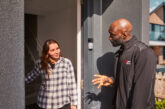
The team at NICEIC provide guidance for the contractor on the installation of twisted pair network cables to BS ISO/IEC 11801 and BS EN 50173 series, and compliance with BS 7671 requirements.
Many commercial and industrial installations employ networking cables for their main infrastructure of Ethernet networks, enabling a permanent and reliable link for communication between items of equipment such as work station computers, printers and network servers. However, some devices, such as those used to control office lighting, work on a connected bus system operated through a software interface including, typically, multi-pair cables having a screened data pair and unscreened power pair.
Within the home, smart devices such as entertainment equipment, lighting and heating control systems often require a network connection. This connection, typically based on a local area network (LAN), allows such devices to:
-access internet-based data sources and services; to retrieve the latest information such as the weather conditions for enhance energy efficiency,
-give the user greater control and monitoring of connected devices while away from the home, to further improve energy performance and/or provide increased security property monitoring.
In larger premises, the use of access points (AP) for expansion of the wireless network may be an option, although these devices typically require a separate network cable, such as a twisted pair cable, which allows for data and power to be transmitted within the same cable. This is often referred to as Power over Ethernet (PoE).
Although many devices can connect wirelessly to a network, such connections are generally limited in range, susceptible to security breaches and can suffer from interference due to external influences, leading to poor signal quality or loss of signal and consequently, failure of equipment.
For this reason, the installation of dedicated data network cables may be a favourable option. In addition to improving the reliability of connected devices,having a direct link to the LAN also permits larger amounts of data to be transferred at increased speed whilst reducing the latency1 between input and output devices.
Twisted pair data cable
Networking data cables are commonly made up of four twisted pairs of copper conductors, although other variants of cables are available (see Fig 2). The twisted pairs are typically used for carrying data signals, a digital pulse or the variations in voltage between (TX+and TX-) and (RX+ and RX-) conductors2. Typically, not all the twisted pairs within the cable are used for the transmission of data.
The performance and ability of a cable to transmit large amounts of data for a particular application depends mostly upon the cable’s grade of construction. These grades are generally categorised (Category 5 – Category 8.2) and are used to identify the amount of data the cable can carry, a measure of high and low bandwidth, and the speed at which the data can be transmitted from its source to output device (transmission speed) (see Table 1).

Bandwidth
The bandwidth is the ability of a cable to carry a signal ranging across upper and lower bands of frequency over a period of time. For example, a Category 5 cable having a maximum bandwidth of 100 MHz would be able to process a signal between point’s fL and fH on a frequency response curve, as shown by Fig 1.

Cable construction
The method of construction varies between the Categories and relates to the performance of the cable. For example, a screened Category 6A cable as shown in Fig 2, is capable of transferring greater amounts of data per second in comparison to that of an unscreened Category 5 cable. This is due to the improved construction, which includes:
-An outer sheath; this may vary between manufacturers but mostly consists of PVC, polyethylene or low smoke halogen (LSZH) insulation3
-Interior separation used for mitigating the unwanted coupling of adjacent conductors and preventing induced noise (crosstalk) transference between each twisted pair of conductors
-Inner aluminium foil screen prevents external noise (alien crosstalk4) from disrupting the transmitted signal
-Conductors, vary in cross-sectional area (csa) between categories. Typically for Category 6A the csa is 0.258 mm2 solid copper, generally covered with high density polyethylene insulation, arranged in four twisted pairs
-The twisting arrangement of conductors varies in pitch between the pairs of conductors within the cable and is measured in twists per inch (TPI). This helps to reduce the internal crosstalk or electromagnetic interference between pairs of conductors, allowing for pure signal distribution with less error.
The TPI is typically increased between the pairs of conductors in a Category 6A cable compared with that of a Category 5.
Cables having stranded copper conductors provide greater flexibility and would typically be used for patch cables or for final connections to portable devices.
Cable termination
The connection of electronic equipment is referenced in the IEC 60603-7 series and relates to the interface of Category cables and the termination of conductors, as shown in Fig 2. There are two standards for the connection of RJ-45 terminations, these include T-568A and T-568B (defined in the US standard ANSI/TIA/EIA-568.2-D), which relate to the order of terminations of conductors within that standard.
It is critical to have correct and adequate terminations at both ends of the cable. Any poor termination will reduce signal strength, cause a loss or noise in the transmitted signal creating distortion and data error.

Power over Ethernet (PoE)
The PoE applications use either two or four pairs to deliver power to terminal devices; power can be transmitted over data conductors. Other applications may include the distribution of a DC power supply through a device such as an Ethernet switch, used to connect equipment such as lighting controllers, IP cameras and wireless access points over the same data network cable.
Requirements of BS 7671
The requirements of BS 7671 are applicable to the installation of network data cables within a building – refer to (110.1.2 indent (vi)).
Network cables are often distributed throughout the fabric of a building, usually from a central location, which makes it possible for them to be in contact with, or close proximity to, other cables having different operating voltages.
To minimise the risk of interference between cables of different voltage levels:
-Band I and Band II circuits shall not be contained in the same wiring system as circuits having a nominal voltage exceeding that of low voltage, and
-Band I and Band II circuits shall not be contained within the same wiring system, unless one or more of the conditions in indents (i) to (iv) of Regulation 528.1 are met.
Where network cables of Band I are installed in a duct or shared void underground, and/or cross with cables of Band II, segregation should be provided to achieve a minimum separation of 100 mm. Where this is not practical, mechanical protection shall be provided (528.2).
Similarly, network cables are often terminated within patch panels or media cabinets enabling peripheral equipment such as Ethernet switches, routers and entertainment equipment to be contained within one location. However, mixed voltages are likely to be grouped within the same assembly in which segregation will be required (515.2).
It is important to recognise, that where necessary, adequate support must be provided for Band I networking cables to prevent their premature collapse in the event of a fire (521.10.202). This may be achieved in a number of ways including:
-metallic clips inside or outside of plastic trunking
-metallic saddles holding plastic conduits
-metallic clips on wall-mounted cables.
Cables installed in steel trunking/conduits and on top of cable tray/ladder rack are not considered to be an entanglement risk. Similarly, additional support is not required for cables installed in floors, above ceilings or behind plasterboard.
Furthermore, the methods used for sealing low voltage cable penetrations within a building structure also apply where data networking cables are installed. Such sealing arrangements area fundamental requirement of the Building Regulations in England, Wales, Scotland and Northern Ireland, in addition to the requirements of Regulation Group 527.2 of BS7671.
Summary
Where it is necessary to install network data cables for equipment within a building, installers need to be mindful of the suitability of a cable for a particular application; reference should always be made to manufacturer’s recommendations.
In addition, where such types of cable are likely to be installed in proximity to cables of mixed voltages, creating a potential for interference and signal error, segregation shall be provided.
The need to provide adequate support for Band I networking cables for the prevention of premature collapse in the event of a fire must also be considered.
Key references
1. The term latency describes the time delay of a data signal having been sent from a source and the receiving device acting upon the signal received.
2. TX+ and TX- are the pair used for transmission whilst RX+ and RX- are the receiving signal pair.
3. Manufacturers often reference a cable sheath having (LSZH), although Construction Product Regulations (CPR) specify a particular code highlighting product conformity for example, BS EN 50399 B2ca s1a d1 a1.
4. Alien crosstalk is referenced in BS ISO/IEC 11801 series, which relates to the induction electromagnetic interference from neighbouring cables.
To get more details about NICEIC membership and benefits, click here








